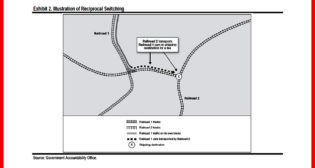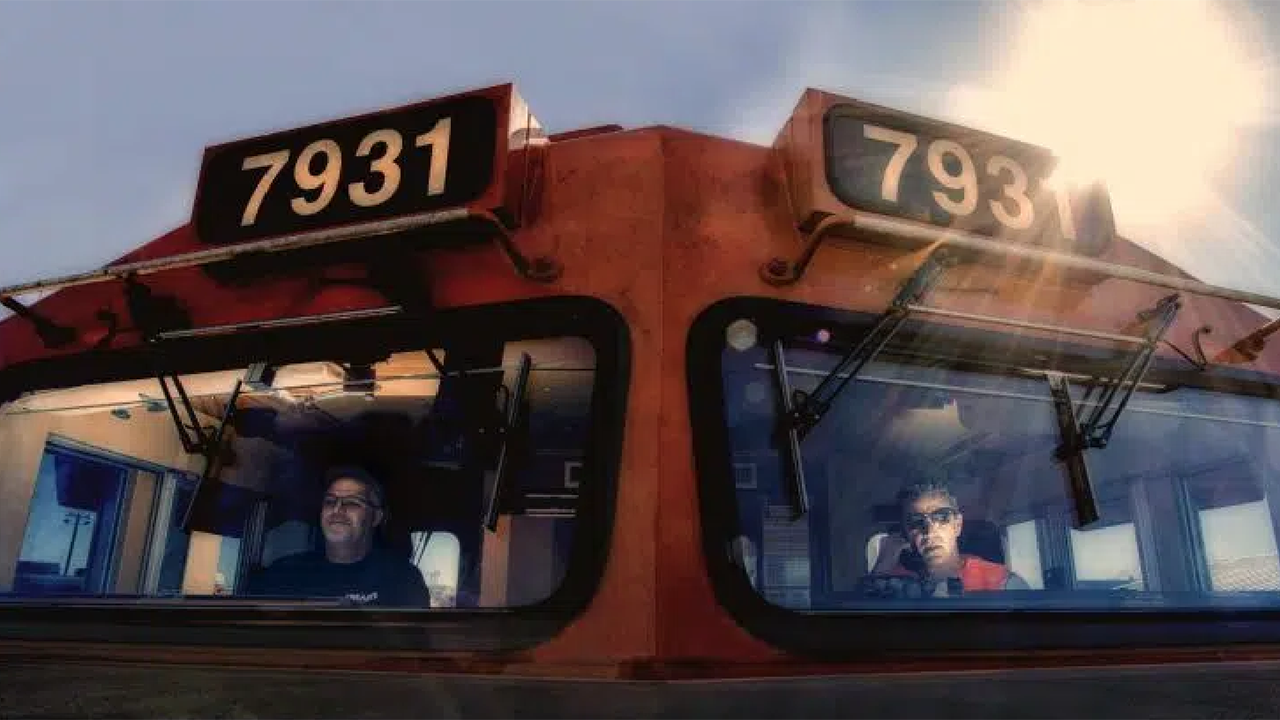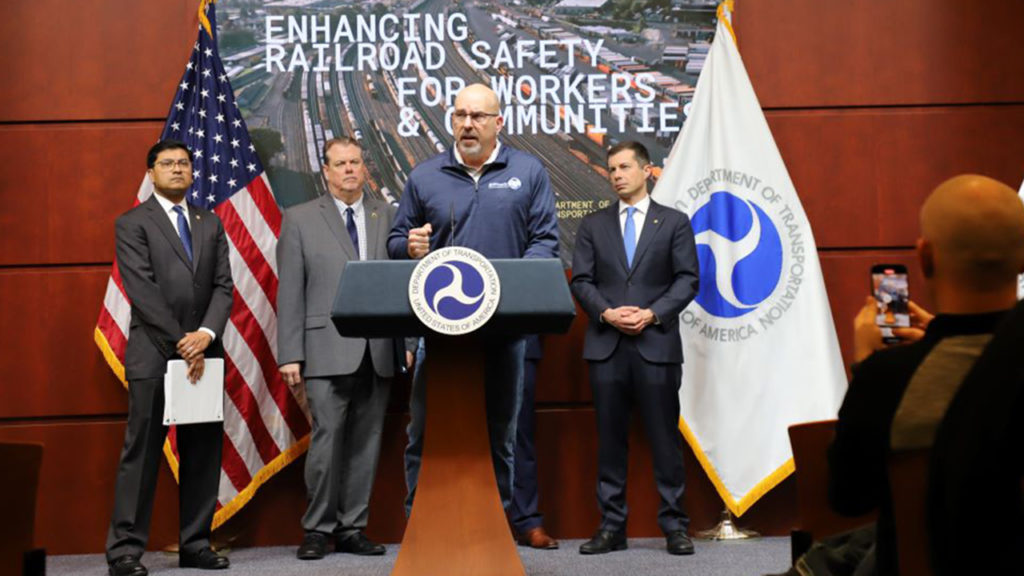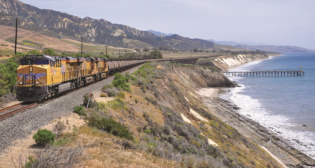
FRA Crew Size Rule: Politics Prevail (Updated With Additional Commentary)
Written by William C. Vantuono, Editor-in-Chief
SMART-TD photo
The Federal Railroad Administration on April 2 issued a final rule, 49 CFR Part 218 [Docket No. FRA-2021-0032, Notice No. 5], RIN 2130-AC88, Train Crew Size Safety Requirements “establishing minimum safety requirements for the size of train crews” that, while it doesn’t specifically preclude railroads from operating trains with one person crews (OPTO, “one-person train operations”), it makes it extremely difficult, if not impossible, for them to do so, going forward. Surprise, surprise!
Recall that currently, based on existing labor agreements, no Class I uses OPTO. Some Class II and III carriers do, and they are treated differently in this rulemaking. Not so startling is the rulemaking’s timing—a Presidential election year, even though, in reality, this rulemaking in the public-opinion arena does little more than make for dramatic media sound bytes and will have no effect on an election outcome.
Little is new here: “The FRA has produced no evidence that two-person crews are safer than single-person train operation,” Capitol Hill Contributing Editor Frank Wilner opined 10 years go. “Indeed, Class I freight railroads currently utilize two-person crews under collectively bargained labor agreements, meaning the FRA intent now to require them is academic,. Moreover, the Association of American Railroads has assured the FRA that the freight railroad industry will not reduce train-crew size prior to implementation of PTC. ‘Unfortunately, the FRA has rejected this logical, good-faith effort,’ AAR said.”
Further, wrote Wilner a decade ago, “In 2009, the FRA said it had ‘no factual evidence to support [a] prohibition against one-person crew operations.’ The California Public Utilities Commission concluded a two-person crew ‘could aggravate engineer distraction,’ while the National Transportation Safety Board does not oppose phasing out two-person crews as other safety enhancements, such as PTC, are implemented. Yet in April [2014], the FRA, at the urging of labor, said it would promulgate a rule requiring two-person crews. Privately, some at FRA disparage the agency’s effort as ‘the Book of Mormon,’ saying FRA lacks data, and its arguments are ubiquitous with the term ‘we believe.’ With U.S. crude-by-rail accidents traceable entirely to rail flaws, the data-phobic FRA’s motive in requiring two-person crews is highly suspect, and diverts scarce resources that should be focused elsewhere. Regulatory actions should be data driven. Yet when a carrier official suggested a data-driven approach, an FRA official responded—according to FRA-prepared meeting minutes—‘What would be the objective of this exercise?’ That the FRA Administrator is a former union officer legitimately adds to anxieties.”
It’s deja vu all over again (thanks, Yogi Berra).
The rulemaking is 223 pages long, and you can download it below. FRA says it “enhances safety in the rail industry by generally requiring and emphasizing the importance and necessity of a second crew member on all trains. A second crew member performs important safety functions that could be lost when reducing crew size to a single person. Without the final rule, railroads could initiate single-crew operations without performing a rigorous risk assessment, mitigating known risks, or even notifying FRA. The final rule closes this loophole by establishing minimum standards and a federal oversight process to empower communities and railroad workers to make their voices heard by allowing for public input during FRA’s decision-making process on whether to grant special approval for one-person train crew operations. In finalizing this rule, FRA reviewed and considered more than 13,500 written comments received during the 146-day comment period—in addition to the testimony from a one-day public hearing.”
The final rule “codifies train crew staffing rules at a federal level, ensuring that freight and passenger rail operations are governed by consistent safety rules in all states,” FRA says. “This is an ongoing issue as Ohio, Virginia, and Colorado, among others, have recently considered legislation to require two-person rail crews. In addition, the final rule contains some differences from the initial notice of proposed rulemaking in how it treats freight railroads, especially Class II and III freight railroads. In limited cases, the rule permits exceptions for smaller railroads to continue or initiate certain one-person train crew operations by notifying FRA and complying with new federal safety standards.”
A few excerpts:
• FRA is establishing minimum safety requirements for the size of train crews depending on the type of operation. This final rule requires railroad operations to have a minimum of two crewmembers except for certain identified one-person train crew operations that do not pose significant safety risks to railroad employees, the public, or the environment. This final rule includes requirements for railroads seeking to continue certain existing one-person train crew operations and a special approval process for railroads seeking to initiate certain new one-person train crew operations. This final rule also requires each railroad receiving special approval for a one-person train crew operation to submit to FRA an annual report summarizing the safety of the operation.
• FRA will ensure that laws, regulations, and orders ‘related to railroad safety’ with respect to train crew size are nationally uniform by preventing varying State laws regulating crew size from creating a patchwork of potentially inconsistent rules governing train operations across the country. Without this rule, railroads could be subjected to a different crew staffing law in every State in which they operate, as there would be no assurance that State laws governing crew size would be based on an analysis or determination concerning impacts on railroad safety. The lack of a uniform standard would likely result in additional costs and operational inefficiencies.
• Sections 218.125 through 218.131 of this final rule provide criteria for instituting one-person train crew operations in certain circumstances through exceptions to the two-crewmember mandate, conditional exceptions based on the type of operation, or a special approval process option. These avenues of relief address operations by small businesses, which for purposes of this rulemaking are primarily short lines and regional railroads. The final rule will give small businesses greater flexibility without sacrificing safety, since the operations of railroads that qualify as small businesses are generally less complex than the operations of Class I railroads.
So, if a Class I wishes to go OPTO, it is now required to submit a petition request to FRA and go through a complicated safety assessment. Buttigieg’s comments at an April 2 press conference, taken at face value—granting of such petitions will be “the exception rather than the norm”—virtually guarantee that evolving to OPTO under the proper circumstances (i.e. with technology that reduces or mitigtes human error) is functionally impossible. While the industry doesn’t have to face this immediately, sooner than later it could one day become a real impediment to progress.
FRA’s thinly disguised message here is that railroads don’t want to operate safely. That’s sheer nonsense. And from a financial standpoint, safety is good business—good for customers, good for employees, good for shareholders. It goes straight to the bottom line. Experienced railroaders, agreement and non-agreement, know this and do their best to practice it.
Train Crew Size Safety Requirements is little more than a feelings-driven—not data- or science-driven—political exercise for an Administration and Department of Transportation that says one thing, does another and is out of touch with reality and 21st century railroading. USDOT has pushed “innovation” for other modes—advancing autonomous motor vehicles, for example—but is treating the railroad industry far differently. This backwards-looking view of the North American rail industry is emblematic of the USDOT’s world view of rail. It’s putting a stranglehold on progress, and in the long run, everyone suffers.
Secretary Buttigieg and FRA Administrator Bose cite “common sense” reasons for regulating crew size. I don’t see any application of common sense here. So much for modern technology, and all the research, testing and effort the industry and its suppliers devote to improving safety and efficiency. Keep in mind that headcount reductions resulting from technology (remote control locomotives, caboose elimination, crew size reductions from 5 to 2, etc.) were accomplished through collective bargaining, while railroads have continuously become safer. Now, after the past 50 years-plus years of fact-based positive change, government needs to insert “common sense” into a proven free enterprise equation? That’s senza senso.

AAR: “Unfounded and Unnecessary”
Citing that the FRA in 2019—under former Administrator Ron Batory, a career railroader with more than 40 years of experience in operations and management—“abandoned a similar rule after failing to identify evidence to justify a safety need,” AAR stressed that “historically, railroad staffing and crew size policies have been managed through the collective bargaining process, which provides for direct dialogue between rail carriers and the unions representing their employees. The FRA’s overreach into this area will diminish the importance of collective bargaining by inserting the regulator between parties.”
AAR notes that railroads “prioritize data-driven safety improvements through extensive employee training and private investments in technology and infrastructure. These actions have driven tangible results: The casualty rate for Class I employees has dropped by 63% since 2000—reaching an all-time low in 2023—and the overall train accident rate is down 27% since 2000 and 6% since 2022. Each year, railroads devote billions to enhance their infrastructure, deploy safety technologies and invest in their employees to help the industry deliver safely and reliably into the future.”
“FRA is doubling down on an unfounded and unnecessary regulation that has no proven connection to rail safety,” said AAR President and CEO Ian Jefferies. “Instead of prioritizing data-backed solutions to build a safer future for rail, FRA is looking to the past and upending the collective bargaining process. Railroads are committed to working with our union counterparts and policymakers to build on this momentum and advance proven solutions that meaningfully advance safety. Unfortunately, the crew size rule takes the industry in the exact opposite direction.”
Frank Wilner has another comment here, and it’s from 2019:
I doubt if Greg Regan, President of the Transportation Trades Department (TTD) of the AFL-CIO, would consent to being interviewed on this subject. The closing paragraph of his statement on the rulemaking—particularly, the final sentence—is rather telling: “We thank President Biden for ensuring that his Administration delivered this essential rail safety rule. We look forward to continuing to partner with Secretary Pete Buttigieg and Administrator Amit Bose to ensure the strongest possible safety standards in the rail industry. We also salute the Biden Administration’s strong commitment to rail safety and continuing support for paid sick leave agreements for all rail workers.”
Let’s not forget that the railroads, working closely with the unions, initiated paid sick leave agreements—not the White House.
Brotherhood of Locomotive Engineers and Trainmen Eddie Hall joined the haymaking chorus: “For the past 13 years our union has advocated for a federal rule requiring that trains be staffed by a minimum of one certified engineer and a certified conductor. We also have repeatedly tried to reason across the bargaining table for railroads to adopt these minimum staffing requirements. As trains, many carrying hazardous material, have grown longer, crews should not be getting smaller. I personally have operated freight trains that stretched more than three miles in length … Eleven states, concerned about the public’s safety, have now instituted a two-person crew requirement. Rail safety legislation now pending in the U.S. Senate also calls for a minimum of two people operating a freight train. [This rulemaking] is an important step in making railroading safer in every state, rather than a piecemeal approach. The Administration promised to take this action and today it happened.”
Enough with the Jeremy & Eddie Let’s Trash Our Employers Show. At least I gave you guys some ink, right? If you have a response, I’m happy to publish it under your bylines in this space. Railway Age is an equal-opportunity organization. Just keep it civil, OK? The same offer applies to Buttigieg and Bose. My email is on the masthead. I look forward to hearing from you—but I’m not holding my breath.
Finally, how about the Railway Labor Act, which Congress enacted 98 years ago to—in the words of the FRA (download its description below)—“as the joint work product of rail labor and management. It was amended slightly in 1934 and 1966, and expanded to include airlines in 1936 … Special bargaining dispute resolution procedures applicable to publicly owned and operated rail commuter carriers was added in 1981 … The RLA is administered by the National Mediation Board, an independent Federal agency … The purposes of the RLA are to avoid any interruption of interstate commerce by providing for the prompt disposition of disputes between carriers and their employees and protects the right of employees to organize and bargain collectively. The RLA imposes a duty on carriers and employees to exert every reasonable effort to make and maintain collective bargaining agreements, and to settle all disputes, whether arising out of the application of such agreements or otherwise (emphasis mine).
One wonders why current SMART-TD and BLET leadership appear reluctant (or “don’t have the guts or wherewithal,” as one industry veteran tells me) to leave crew size where it belongs: in collective bargaining agreements, as did labor leaders of years gone by. Why do they chose to hide behind a mantle of political expediency? This is all about perpetuating the historical identity and independence of rail unions through membership. In the past 50-plus years, this industry has gone from 600,000 workers at 50-plus Class I’s to 160,000 workers at six Class I’s, yet still recognizes 12 rail unions. Safety is being used as a pawn for protecting membership status quo. The rail unions need to merge for the long-term benefit of their membership. There is strength in numbers. Look at the automotive industry, with only one union: The United Auto Workers (UAW, fully named the International Union, United Automobile, Aerospace and Agricultural Implement Workers of America), has more than 391,000 active members and more than 580,000 retired members in more than 600 local unions, and holds 1,150 contracts with some 1,600 employers, and assets amounting to just over $1 billion.
(“Many unions have merged, actually, but with larger non-rail unions owing to financial needs,” Wilner, author of Understanding the Railway Labor Act and a former UTU official, points out. “BLE and UTU attempted seven times to merge, but members of one or the other each time rejected it. UTU (now SMART-TD after a merger with Sheet Metal Workers) actually is a consolidation of numerous former individual unions—Brotherhood of Railroad Trainmen, Brotherhood of Firemen and Oilers, Order of Railroad Conductors, Railroad Yardmasters of America, and others. Transportation Communications Union is a consolidation of Brotherhood Railway Carmen and Brotherhood Railroad and Airline Clerks. It’s rather complicated.”
The political circus atmosphere (perpetuated mostly by pagliacci), the attacks on the rail industry from all sides, are disheartening, disturbing. In my nearly 32 years covering this industry for Railway Age, I have never seen anything like this.
Bottom line: Crew size should be negotiated, not regulated or legislated.



